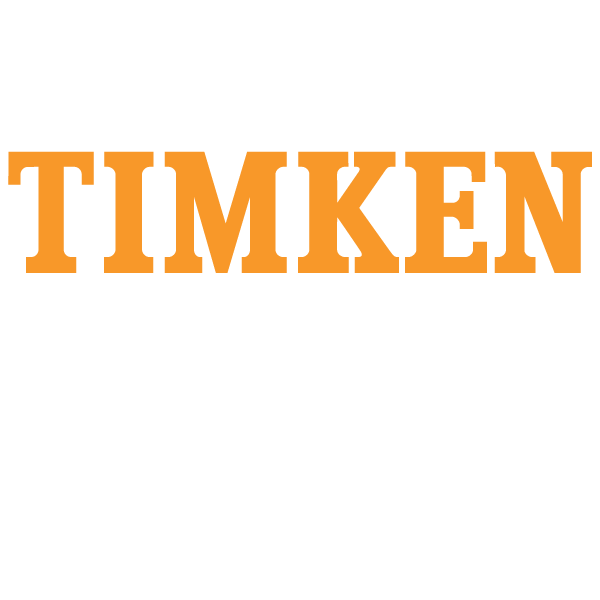

ENGINEERING
8 TIMKEN
ANGULAR CONTACT BALL BEARING CATALOG
ENGINEERING
BEARING LIFE
The selection of the appropriate bearing for a given application is dependent on several performance criteria. These include bearing fatigue life, rotating precision, power loss requirement, temperature limits, speed capabilities and sound requirements. This section deals primarily with bearing life as related to material-associated fatigue. Bearing life is defined as the length of time, or number of revolutions, until a fatigue spall of 6 mm
2
develops. Since fatigue is a statistical phenomenon, the life of an individual bearing is impossible to predetermine precisely. Bearings that may appear to be identical can exhibit considerable life scatter when tested under identical conditions. Thus, it is necessary to base life predictions on a statistical evaluation of a large number of bearings operating under similar conditions. The Weibull distribution function is the accepted standard for predicting the life of a population of bearings at any given reliability level.
RATING LIFE
Rating life (L
10
) is the life that 90 percent of a group of apparently identical bearings will complete or exceed before a fatigue spall reaching criteria develops. The L
10
life also is associated with 90 percent reliability for a single bearing under a certain load.
DYNAMIC LOAD RATING
Published dynamic load ratings for angular contact ball bearings are based on the industry standard procedure outlined in ISO 281:2007. This rating is designated as C
r
and is defined as the radial load under which a population of bearings will achieve a L
10
life of one million revolutions. Radial load is assumed to be constant in magnitude and direction for radial ball bearings.
STATIC LOAD RATING
The standard static load rating for Timken bearings (designated as C
0r
) as defined in ISO 76:2006 is based on a maximum contact stress within a non-rotating bearing of 4200 MPa at the center of the most heavily loaded rolling element and raceway contact. Such stress levels may cause visible light Brinell marks on the bearing raceways. This degree of marking will not have a measurable effect on fatigue life when the bearing is subsequently rotated under a lower application load. If sound, vibration or torque are critical or if a pronounced shock load is present, a lower load limit should be applied. For more information on selecting a bearing for static load conditions, consult your Timken sales engineer.
SPEED RATING
THERMAL REFERENCE SPEED
The thermal reference speed is the bearing thermal equilibrium speed based on industry standard reference conditions outlined in ISO 15312: 2003. Thermal equilibrium balances the heat generated by the bearing, with heat conduction through the housing and shaft. This standard applies to both bath oil lubricated and 30 percent grease fill packed bearings. It excludes any heat removed by a circulating lubricant. This standard also excludes the outer ring rotating application and heat generated by contact seals. The ISO 15312 thermal reference speed rating calculations are based on the following assumptions: The bearing ambient temperature is 20 C. The tolerable bearing/housing interface temperature is 70 C. Oil and grease lubricants are considered. For radial bearings with oil lubrication: ISO VG 32 oil. For radial bearings with grease lubrication: ISO VG 150 grease. The radial loads assume a normal clearance (C0 or CN). For radial bearings, the applied load is 5 percent of the static load rating (C
0r
). Thermal reference speed ratings assume the bearing has been sufficiently broken in. During the break-in process, temperatures may exceed the tolerable limit. Break-in commonly takes between 10 to 36 hours. Standard bearing materials and lubricants can generally withstand temperatures up to and beyond 100 C. For this reason, a permissible temperature of 100 C was assumed for the thermal speed rating calculation. Contact your Timken sales engineer if your application requires speeds above the Timken published values.
LIMITING SPEED
The limiting speeds for single- and double-row open bearings are listed in the product data section (pages 23 to 27). The values depend on grease or oil lubrication, and on the various designs of open, sealed, and shielded configurations. The values listed for single-row designs reflect the lubrication types and are valid only for open bearing design configuration. For the double-row sealed bearing configuration, the seals themselves become the limiting factor due to the additional heat generation at the contact points; therefore the grease speed values take into account the seals. The values listed for double-row bearings with oil lubrication are for the open bearing configuration.
Previous Page
